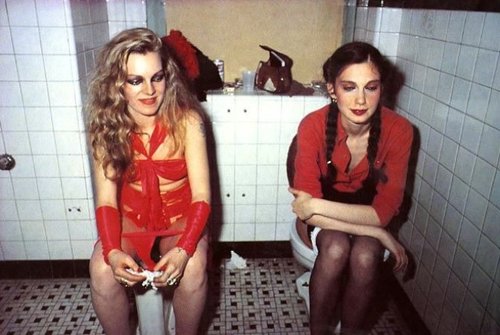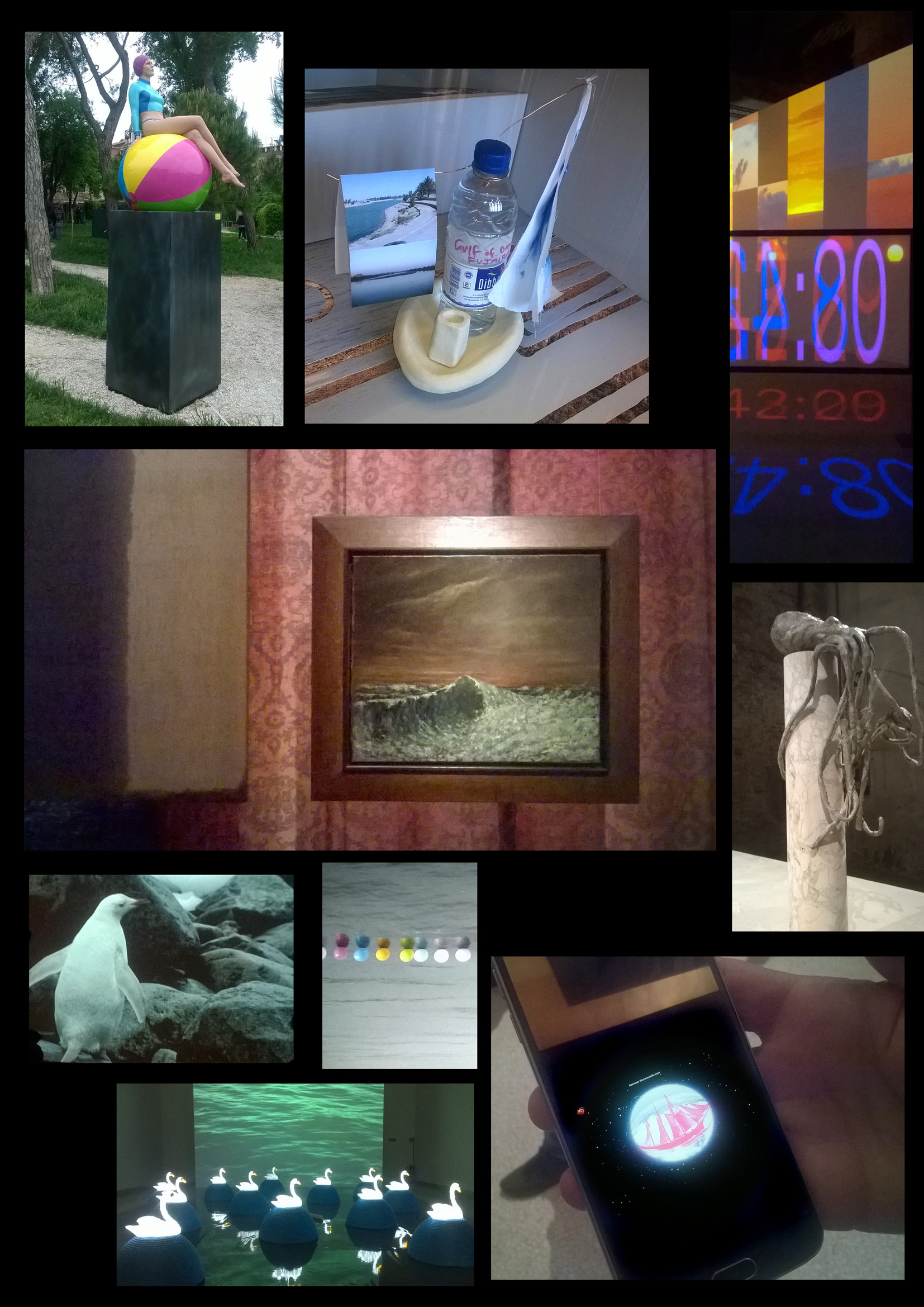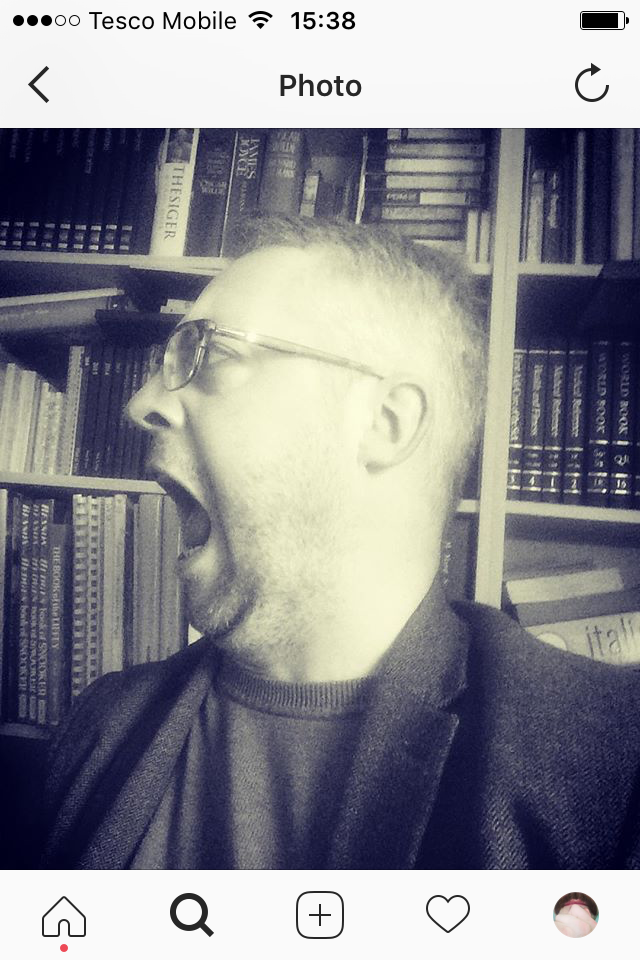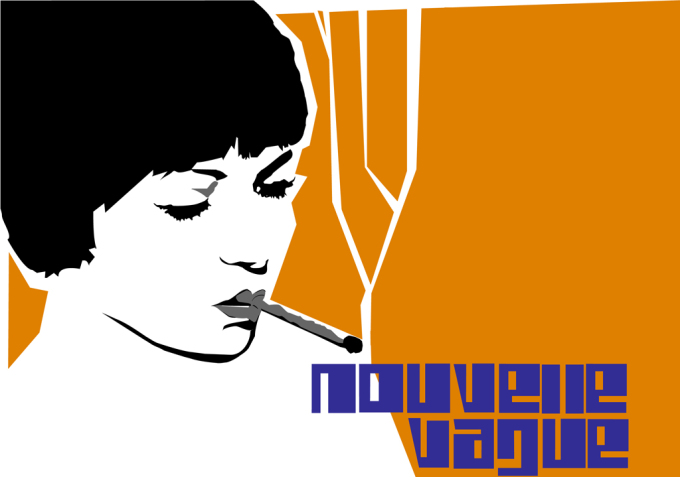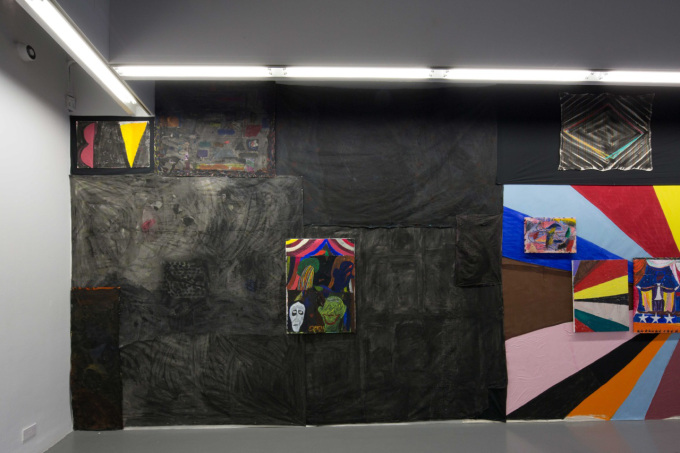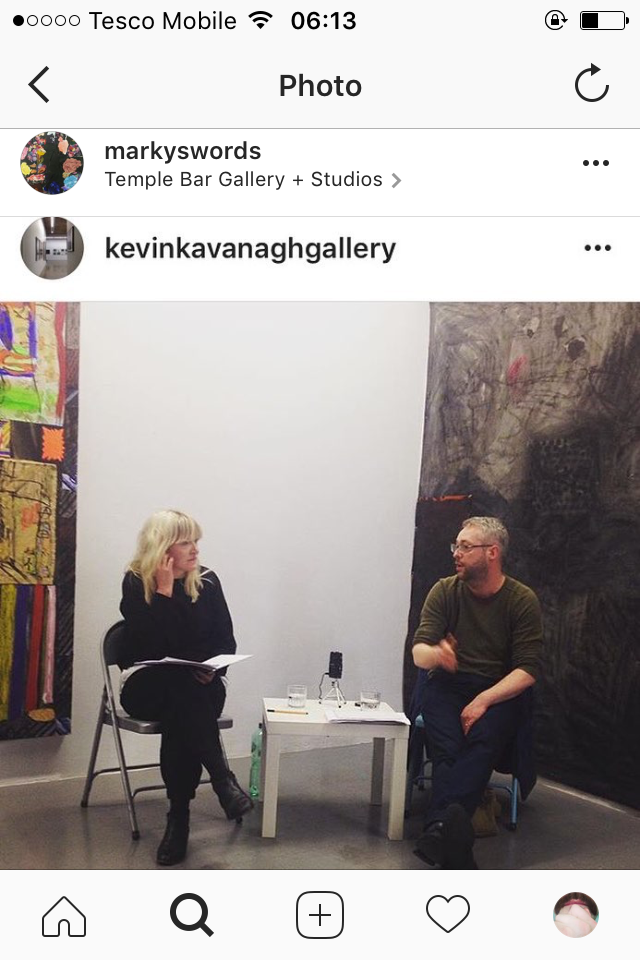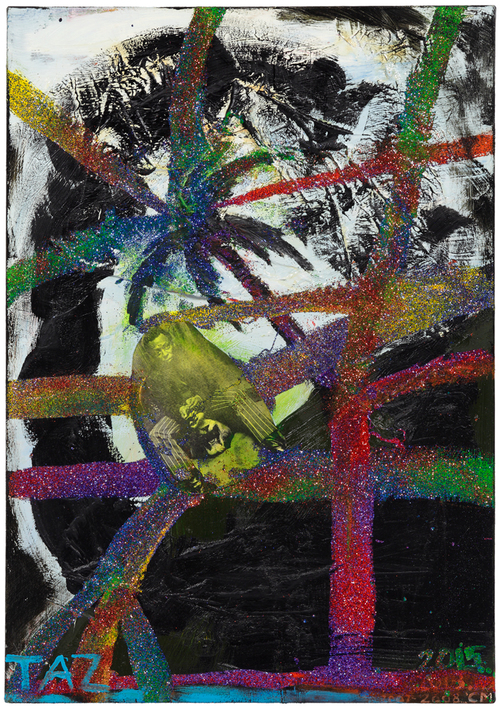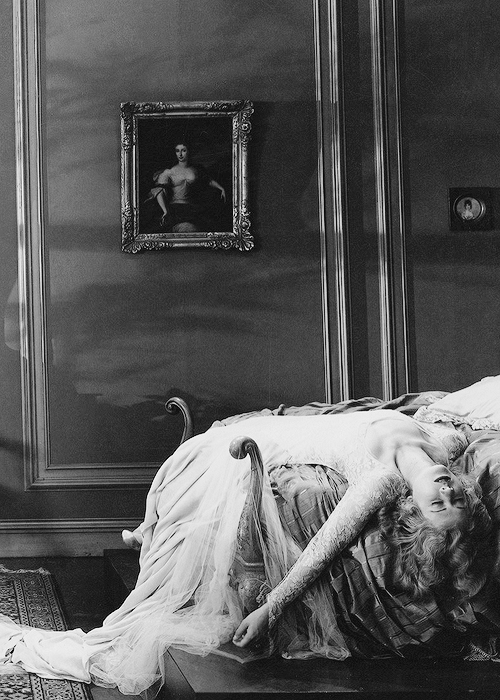The sun was a headlight.
I was driving the other morning to work. I decided the night before that I would listen to David Foster Wallace’s commencement speech en route to the art school where I tutor one day a week, in order to judge whether it was relevant to the lesson I was delivering and appropriate for the students I was tutoring. After showing it I’m still not certain about either.
On the YouTube video you are given just a still image of Wallace while you listen to his recorded voice. He stands at a podium set against a milky-tea backdrop. He wears long hair, short-sleeves, glasses and a beard. His arms are spread, sermon-like. But beneath this Jesus Christ posture his brow seems to buckle a little under the weight of some inner burden that would be found out three years later when Wallace would take his own life at age 46.
While listening to his voice in the car I begin to imagine the audience of graduates at the American College where this speech took place in 2005. They are gazing up with theoretical appreciation at the wiser and older Wallace while clapping and laughing out of beat with his message. “Wise old fish” among younger fish is something Wallace professes he is not to the student cohort on that day, with that type of self-criticism that bespeaks a thinker and writer who was relentlessly self-critical underneath his lexical command of the world. A tortured narcissist, terribly alone.
Rather than badly retell what Wallace posited on that “dry and lovely morning” at Kenyon College Ohio, I will get to the heart or at least a chamber of his speech’s sentiment: each and everyone of us is a hardwired narcissist, stuck most of the time in what Wallace refers to as our “default-setting” of self-centredness. We battle this self-centredness every time we are met by that ubiquitous obstacle and annoyance, other people, what Sartre too famously called “Hell”. To paraphrase Wallace: ‘I am the centre of the Universe and the world orbits me. I am gravity.’
But we have a choice in all of this according to Wallace. We can choose how to think, how to construct meaning from quotidian experience. We can choose to be aware of ourselves and other people. (Sometimes I want to crack my skull open, so maybe, just maybe, I could get a peek at the multitude blind spots – I think Wallace found a way to do so that granted him both beautiful insight and ugly self-injury.)
Narcissism isn’t what we are made to think it is in popular culture. The narcissist is not what Gore Vidal playfully diagnosed as being “better looking” than you or me. It’s more deep-seated than mere surface. Let’s not forget Narcissus was vengefully led to the pool where he found himself locked into his own reflection. Caravaggio’s painted image of Narcissus is not a glorious metaphor for self-fulfilment. The self is an obsession that obsesses us all, that consumes us when allowed. And when you look too hard at something you begin to see the cracks; or if none visible you start to invent them.
Wallace talks about the traits of narcissism in his speech but he doesn’t use the word narcissism, even though he suffered the self more than most. What Wallace does talk about is worship, and how the worship of gods or idols or whomever is a way of saving ourselves from ourselves. Whereas money-worship, image-worship, intellect-worship is a still pool in waiting.
In a sense we are always circling the pool, crestfallen, so looking up into the infinite heavens is all we can do to keep ourselves from falling into that deep sinkhole of self. That reflection shimmering in the pool beneath us at the perfect angle can be upset by the slightest perspective shift. So we don’t naturally shift perspectives because our psyches are riddled with protective blind spots. Fresh trauma is the only cure for psychic propulsion.
It’s why Caravaggio’s 400 year-old Narcissus in paint is so compelling; his gaze is literally set in paint forever without hope of escape because of the painting’s cultural value and historical significance. In essence we can’t let him escape his self because we adore him so much.
I turn the radio off and the sun becomes a sun again. I am on this long bridge and rush-hour traffic is a mercury stream that catches the colours of the rising sun. At the end of the bridge is a junction where cars are packed just as tight as the cars on the bridge. But no one on the bridge is letting the little fish out; they are trapped and wanting, pleadingly looking upstream.
After just listening to Wallace the meaning of irony was never as clear as it was on that day, and it was a good day. Here I am at this junction, a crossroads if you will, and choices are being made and given every second that a car on the bridge chooses not to let one of the little fish out at the little junction. Those little fish are pleading with their eyes, everything agape. But the drivers on the bridge don’t make eye contact lest they’d have to submit to self-compromise or guilt. The drivers on the side road are the bystanders, while those on the bridge Superman punch their way across the bridge with the will and purpose that comes with saving the world, their worlds: Clark Kents caught in the revolving door.
The thing is, and it’s obvious to you and me and even them but here it goes anyway: most of the drivers on this bridge will find themselves on the return journey as the little fish on that same little road looking upstream at the bullying bridge traffic. And they will be making the same pleading faces, the roles reversed, the perspectives forcefully shifted.
One day a week I face this junction. I am always anxious about what it represents, how it ticks my cynicism about the world. It’s a small junction among hundreds of thousands of junctions around the country, but this one in particular feels like a testing ground.
It’s a game of percentages in the end. The majority of days when en route back home and stuck at the head of the traffic, willing the cars to let me out, I count them like steel sheep… 1, 2, 3, 4, 5…10…15… before someone stutters and stammers with their lights and hands to go, go! Somedays the driver behind me gets out too.
When you let someone out it’s like you have shot them. It’s funny. Then they compose themselves, wave and put their foot down to get on with their default-setting. But for a split second they are gracious, most of the time.
I return to Wallace’s commencement speech, wondering if it’s a little deep and dangerous for my students. I then return into the fold of one of his many analogies in the speech, in which he describes a workaday day, what he calls the “day in, day out” of adulthood.
His protagonist is a busy and tired worker with a Liberal Arts Degree like his audience in Ohio, who remembers at work that there’s no food at home. So after a long day’s work this worker has to travel through rush-hour traffic, rush-hour shopping, rush-hour ennui, annoyance, inconsideration with a bockety trolley for his troubles.
The moral of the story – even though Wallace says there is none – is that perhaps all those people in rush-hour traffic, rush-hour shopping, experiencing rush-hour ennui, annoyance, inconsideration with bockety trollies are having as bad or a much worse day than you are. That may be your life is, relative to theirs, fucking fabulous.
Returning to the junction, every work morning I let out at least one car. Perhaps if the percentages weren’t so stark I wouldn’t. Who knows. So this day of days I let this driver out and once again I have shot them. Hands up. Agape. Peddle. Metal. Default-setting.
But also on this day of days, with Wallace’s commencement speech ringing in my ears, the car behind me blows the horn. Let’s be clear, I have only gestured one little fish to go at this point. Like being shot in the back of the head I lose brain and motor function and make dumb gestures with my hand, half the middle finger, half a thumbs up, half a wave – hand gibberish. The horn blows again, again, again.
BARK!! BARK!! BARK!! BOLLOX!!!
A BIG BMW (which made it somehow worse). MAN. FAT. BALD. JOWLED. A scalped bulldog spitting and pawing climbs into my rearview mirror. My heart pumps. My pits fill with fear. I stop the car. I let a second car through; the little fish’s face isn’t shot this time because they see what’s going on, a superhero face-off. I want to get out of the car. And that’s there, underneath…violence. I imagine American History X. But what I most want is for him to hear David Foster Wallace’s commencement speech and his “default settings” ringing in my ears.
3, 4, 5… 10 cars escape the pen until I release the brake and the red behind me and inside me subsides.
I move on and think, maybe I’m the asshole. Perhaps that bollox was rushing to the sick, the dying, the dead. That giving away his daughter, his son, was his excuse.
Love was his excuse.
You choose.























![MADDER LAKE ED. #10: TOWARDS A HABIT [ psychoanalytically speaking ]](https://images.squarespace-cdn.com/content/v1/594626eae3df28301b1981dc/1513427037670-14LCX8VBQFY0V1FCMR03/gober-circa-1985.jpg)





















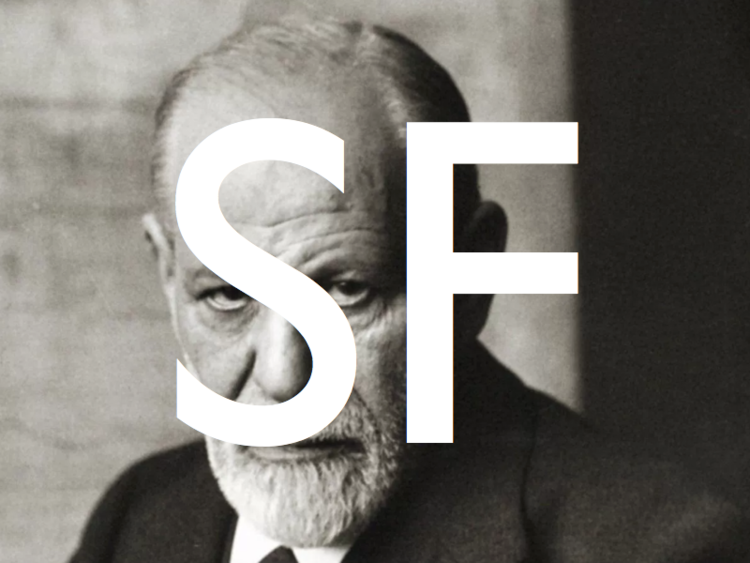














![Sam Thorne School: A Recent History of Self-Organised Art Education Sternberg Press [ 2017 ] : photo : author.](https://images.squarespace-cdn.com/content/v1/594626eae3df28301b1981dc/1513424627102-BAMX0J3GEB0ETLMR4M3S/4.jpg)
![Mad Men Season 1 [ 2007]](https://images.squarespace-cdn.com/content/v1/594626eae3df28301b1981dc/1513424751120-IIPY7UJBIWE5535G82GW/1.jpg)
![Mam & Dad [ The past. ]](https://images.squarespace-cdn.com/content/v1/594626eae3df28301b1981dc/1513424844927-LR7NTICZG4YEGD0TT73T/Mam%2Band%2BDad.jpg)
![Mad Men Season 1 [ 2007]](https://images.squarespace-cdn.com/content/v1/594626eae3df28301b1981dc/1513424947031-MRENZGE7UC91ATX72ZU9/5.jpg)
![Mad Men Season 1 [ 2007]](https://images.squarespace-cdn.com/content/v1/594626eae3df28301b1981dc/1513425037224-2BB0MA9Z1AJS2W1T4I86/2.jpg)














![Lucia Nogueria. [ Where? When? Unknown.]](https://images.squarespace-cdn.com/content/v1/594626eae3df28301b1981dc/1523616721344-K6OAGMSP8YYC12E9IF72/lucianogueiraendswithouff1.jpg)











![[Detail, flipped and mirrored and multiplied]: Daniel Rios Rodriguez, Lights Revolt, 2017, oil and mixed media on panel, 50.6 x 50.8cms. Image: James Merrigan, pointing at a copper pin.](https://images.squarespace-cdn.com/content/v1/594626eae3df28301b1981dc/1507736725050-ADIA0T9QNX1YQSGI87WI/DDR.jpg)



![[Colour-altered] still from Vernissage TV: Paul McCarthy, Life Casts, Hauser & Wirth, New York, 10 May – 26 July 2013.](https://images.squarespace-cdn.com/content/v1/594626eae3df28301b1981dc/1507730331435-EJOPXDNLEHCZ0BDZLFTJ/static1.squarespace.png)






